Nanotechnology is an important emerging technology of our time – it radically intervenes with our sense of what is natural – yet most people are still relatively unaware of its consequences. Hence, this autumn 2010 the Next Nature NANO Supermarket will be presented in Eindhoven (NL): a physical supermarket featuring debate–provoking visions on possible nanotech products expected to hit the shelves between today and 2020.
Designers, technologists and artists were called to submit their speculative nanotech products for the NANO supermarket. A selection of these projects will be presented in the NANO Supermarket and the accompanying publication. On Thursday, June 10th, a NANO Supermarket jury consisting of design and science experts awarded the best submission a € 2,500 prize. Furthermore, three submissions have been awarded an Honorable Mention in recognition of the quality of their project proposals.
GENERAL IMPRESSION
The jury was pleased with the creativity displayed in the submissions, although there were doubts about the feasibility and technological evidence of many projects that have been submitted. On a technological level some designers refer to research projects that underpin the feasibility of a given product. But most of the time such research gives theoretical evidence to only one aspect of a given technological implementation.
In reality there is a whole complex of factors that make it highly difficult to realize many ideas and products that were submitted either with contemporary or near-future technology. In this light the jury wishes to emphasize that many NANO Supermarket entries are fascinating and evocative from a debate-provoking and design point of view, but are still far away from actual realization.
Two groups can be distinguished among the NANO Supermarket entries: on the one hand there are proposals that reveal a good understanding of what nanotechnology entails, but have difficulty to bring in an artistic and visionary dimension. On the other hand several proposals are adventurous, visionary, and strong from an artistic viewpoint, but without having assessed the actual properties and scientific implications of nanotechnology.
PROCEDURE
The NANO Supermarket Call For Products yielded thirty-three submissions from seven different countries. The jury based the final judgments on six parameters: originality, design quality, visual presentation, technological feasibility, socio-cultural implications, and debate provoking potential. The jury consisted of (nano-) scientists, theorists, publicists, artists and designers. Therefore the parameters for judging the entries were fully covered by the jury’s multi-faceted expertise:
Ronald van Tienhoven – Artist, Design Educator, Social & Cultural Expert (Chair)
Prof. Dr. Bas Haring – Philosopher, Writer, Professor for the Public Understanding of Science, Leiden Universtity
Prof. Dr. Bert Meijer – Distinguished University Professor in the Molecular Sciences, TU Eindhoven
Prof. Dr. ing Dave Blank – Professor Inorganic Materials Science, TU Twente
Drs. Karin Spaink – Writer, Columnist, Activist
Dr Lucien Hanssen – Academic Entrepreneur, Promoter of imagination in Science
Prof Dr. Ir. René Janssen – Professor in Physical Organic Chemistry, TU Eindhoven
Dr. Ir. Rinie van Est – Technology Assessor, Rathenau Institute
Taco Stolk – Artist, Founder department of Genetic Design
Winner € 2500 Price
First Prize: Nano-Sock – “Easy up, Easy go” / Nicolas Nelson (NL)
Nano-Sock addresses a problem elderly or physically challenged people encounter every day: how to put on one’s socks or support stockings without assistance? In his product pitch the designer states: “(...) The Nano-Sock is designed in such a way that it eliminates the need for the user to bend over and put on his socks. Different types of nanotechnologies enable the sock to sense the human foot and pull itself up. The sock dresses itself!”
It is a seemingly simple and unassuming proposal, compared to other NANO Supermarket entries with a more ambitious or debate-provoking goal. A special quality of this proposal is a social one: The jury values the fact that Nano-Sock empowers people, because elderly or handicapped people become less dependent on the help of others.
Furthermore, the jury recognizes the full potential of this product when extending it further toward alternative implementations.
From a technological viewpoint the jury recognizes the thoroughness with which the designer connects the required technology with several endeavors of (nano-) scientific research, such as the conversion into electric energy triggered off by fibers covered with nanohairs, a research project developed by Zhong Lin Wang at Georgia Institute of Technology.
The design empathy, evocative power and future vision makes this product worthy of receiving the first prize.
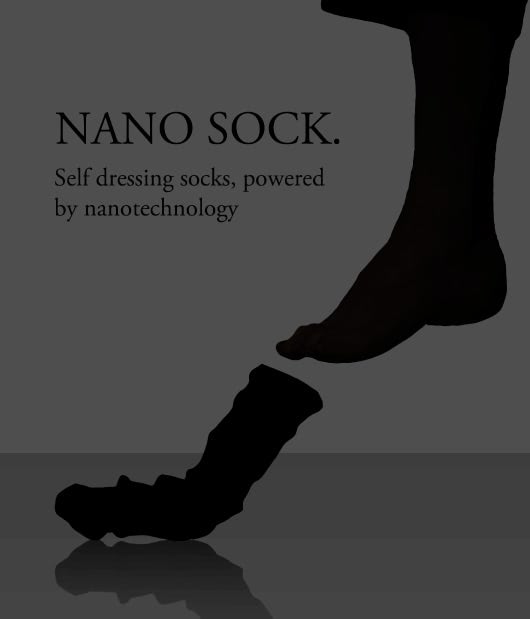
Honorable Mentions
Honorable Mention #1: Skinpaper / Vanessa Harden & Tomasso Lanza (UK/IT)
Skinpaper is a beautiful conversion of high tech into the realm of poetry and social intimacy, where high tech is still underrepresented. In their product pitch Vanessa Harden and Tomasso Lanza state: “ Skinpaper is a product that combines current developments in nanotechnology with the multiple uses of paper to form a scaffold supporting skin cell growth. The paper-like scaffold, in the form of a small notebook, is designed to accept the epithelial cells of the owner, while keeping them alive and nourished, effectively taking a biological snapshot of the owner’s skin.”
Skinpaper deserves an Honorable Mention, because the designers eloquently predict the future ubiquity of nano- and biotechnology, which today are still limited to the scientific and utilitarian domain. The socio-cultural implications are obvious, since the user is able to ‘plant’ his/her precious skin, thus becoming a full-fledged ‘skin graft gardener’. The jury envisions the possibility to use Skinpaper for collecting skin grafts from family, friends or lovers.
The proposal also addresses the notion of where the boundaries of the ‘organic’ and ‘inorganic’ are situated, while challenging their present status quo.
Especially the fact that bio- and nanotechnology are going to be implemented in the personal realm, makes Skinpaper an enticing product for the NANO Supermarket.
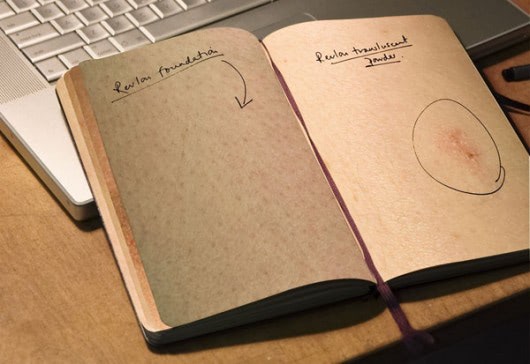
Honorable Mention #2: Wall Smart / Jonas Enqvist (SE)
“Change the color of your walls with a push of a button!” Paint your wall with the “Wall Smart paint”, connect with the wall through your WIFI, choose a color from the “Wall Smart App”, or browse other user’s color schemes”.
Wall Smart is an intelligent, playful and engaging proposal, that, according to nanoscientists in the jury, is technologically feasible. Gone are the doubts and endless discussions with your partner about deciding what color the walls in the house should have. In that respect Wall Smart definitively has a unique selling point. The designer also points out that other functions can be added to the product, such as using it for visualizing someone’s state of health, simply by touching the Wall Smart-covered surface.
Wall Smart deserves an Honorable Mention due to its technical feasibility, its directness in the application of innovative (nano-) technology, its playfulness, and at last but not at least the way the designer visually anticipates the product’s commercial presentation in the NANO Supermarket.
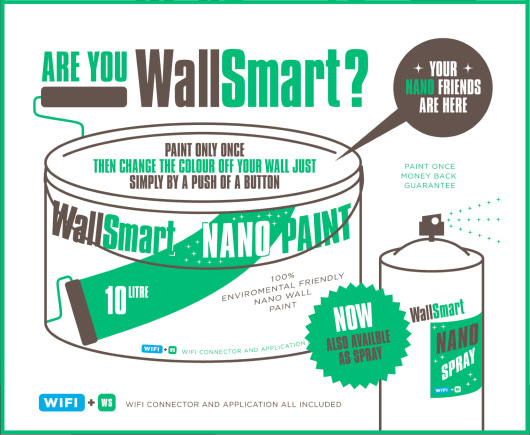
Honorable Mention #3: Bare Conductive/Matt Johnson (UK)
“Bare is a skin safe conductive ink invented by four designers intent on creating a new space between wearable technologies and electronic implants by applying electronic circuitry directly to the skin. A thorough study of the history of body art and ornamentation led to the creation of an ink that humanizes wearable technologies, and provides a sensuous method of applying electronics to the body through customized circuitry.”
There is one decisive reason to select Bare Conductive for an Honorable Mention: conceptually and technologically this product is very close to being put on the market. Although there is not yet nanotechnology involved, the designer states that it can become an integral part of this conductive ink’s future development. Nanotechnology might even be indispensable in optimizing its properties. The jury is convinced that the product will be a valuable contribution to the NANO Supermarket, especially because it represents the burgeoning physical relationship between applied or embedded electronics and the human body. Another positive aspect of Bare Conductive is the wide spectrum of applications that doesn’t only involve the body, but can be used on many different surfaces.
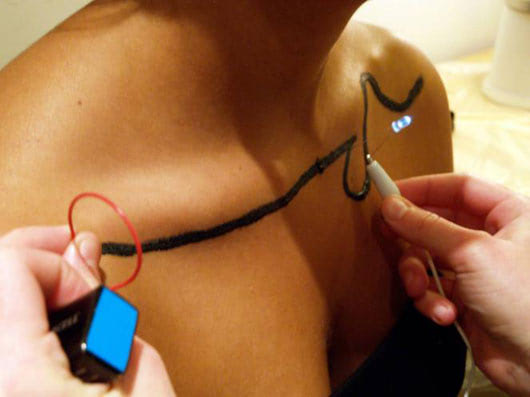
The Next Nature Nano Supermarket will open in the autumn 2010 and the Nano Sock, Skinpaper, Wallsmart, Conductive Ink, plus a selection of the other submitted products will be on display. The NANO supermarket is supported by Nanopodium, an initiative of the Independent Committee for the Societal Dialogue on Nanotechnology in the Netherlands (CMDN).
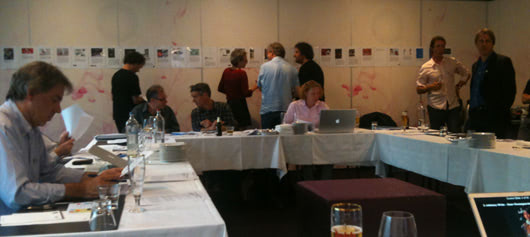
Martijn van Mensvoort
Interesting report!! Uhmm... the 'nano sock' makes me wonder: what IS the 'nanotechnology' in this product? And how far away is the realization of the 'nano sock' really? The jury's comment... "In this light the jury wishes to emphasize that many NANO Supermarket entries are fascinating and evocative from a debate-provoking and design point of view, but are still far away from actual realization." ... raises the question: how realistic were the (winning) pitches in the perspective of current nanotechnology developments? I noticed that the INVITATION for the project did not mention any requirement regarding the specification of how nanotechnology is actually applied in the product design/pitch (the jury's comment did not surprize me). PS. I am also wondering wether nanotechnology is required to develop a sock with the same purpose. I really would like to know!
Posted on
Arnoud van den Heuvel
Congratulations to Nicholas Nelson! Well done Vanessa Harden, Tomasso Lanza, Jonas Enqvist and Matt Johnson.
Posted on